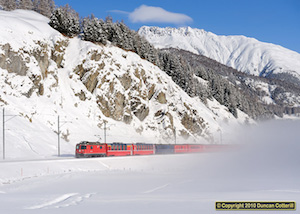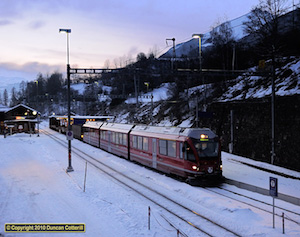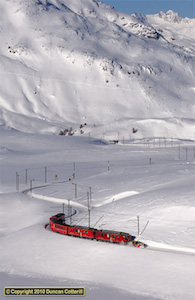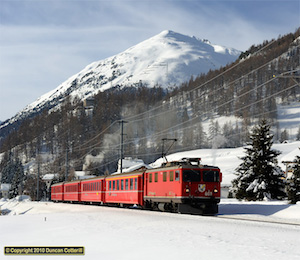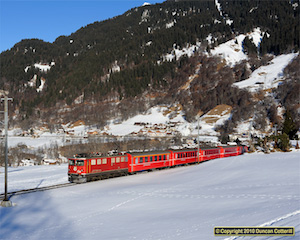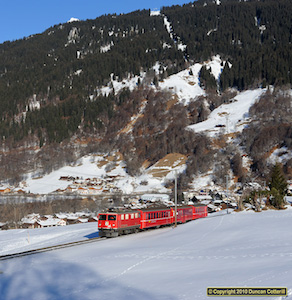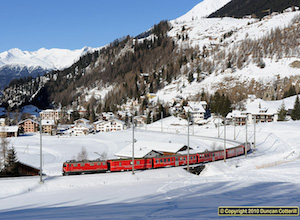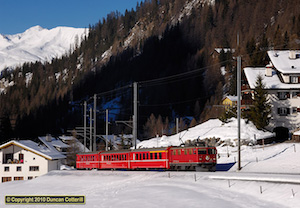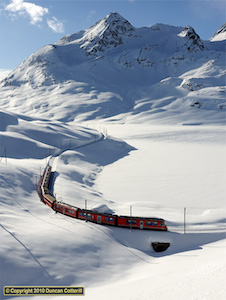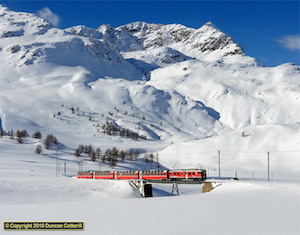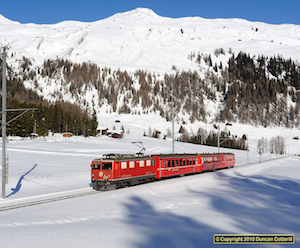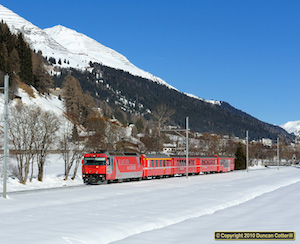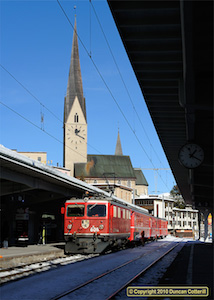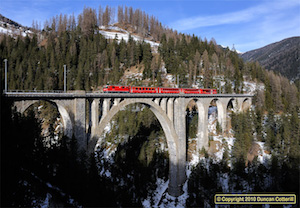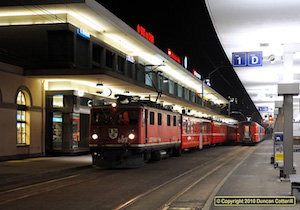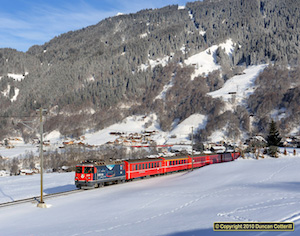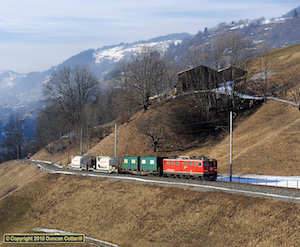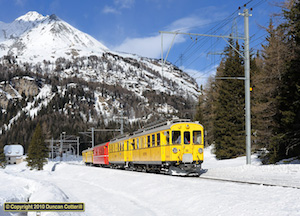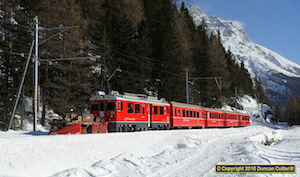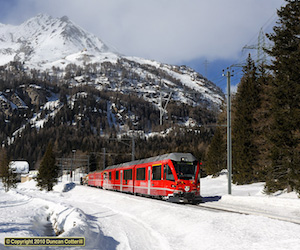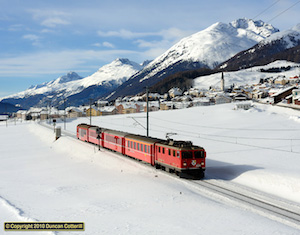Winter on the Rhätischebahn
08 - 20 & 25 - 30 January 2010
Report by Duncan Cotterill
Introduction
This report covers two trips to the RhB in quick succession during January 2010. I had originally planned a 12-day trip but then got the opportunity for another six days away later in the month. With only four days between the two trips, It seemed much easier to go back to the RhB than try to plan something different. I did wonder whether 18 days might be too long but, in the event, it was nothing like long enough.
For those unfamiliar with the RhB, it's an extensive meter gauge system in the Swiss canton of Graubünden, with frequent loco hauled passenger trains and a fair bit of freight as well. RhB lines connect a number of towns high in the Alps, including Klosters, Davos and St. Moritz with the SBB at Landquart and Chur, the MGB at Disentis and FS just across the Italian border at Tirano. As might be expected from a railway that runs through the heart of the Alps, the scenery is magnificent and there are numerous good photo locations.
This report is divided into two parts: This page contains a summary of the trip. The Day by Day section contains details of each day’s activities, trains seen, travel, hotels etc.
Logistics
I flew from Heathrow to Zürich for both trips, using British Airways for the first trip and Swiss for the second. Travel within Switzerland was by train, using ordinary tickets between Zürich and Chur or Landquart and a BüGA within Graubünden. The BüGA, (Grau)Bündner General Abonnement, is a pass giving unlimited travel on trains and most buses within Graubünden, including the entire RhB system. The monthly version costs CHF190 in second class and CHF270 in first class. I bought mine from the ticket office at Chur.
For the first 12 day trip I stayed at the the Hotel Grischuna in Filisur, ideally located at the end of platform 1. For the second trip I used the Hotel Post in the centre of Chur, less than 10 minutes walk from the station.
RhB Operations
These were little changed from the previous year with no significant alterations to the timetable or the loco diagrams. Between late December and early March there are additional services catering for skiers, snowboarders and sledgers and most of these are diagrammed for the oldest engines of class Ge4/4i. Loco duties are as follows......
Ge4/4i
Despite being due for withdrawal in the near future, these old engines are still very busy. Main booked duties include:
- Two of the four push-pull turns in the Engadin covering the Pontresina – Scuol-Tarasp trains and some local workings, mainly between St. Moritz and S-chanf.
- Both the Sportzug turns shuttling between Klosters Dorf and Davos Platz.
- The Schlittelzug shuttling between Bergün and Preda. New this winter is a second turn at weekends, also worked by a Ge4/4i.
- Train 4109 from Chur to Samedan.
- RE1125 between Samedan and St. Moritz.
- Freight 5152 from Samedan to Chur.
- Early and late freight trips from Landquart to Ilanz and back with a trip from Landquart to Jenaz and back in between.
- Train 1250 from Chur to Ilanz plus a couple of evening trains to Arosa on Mondays and a very early morning turn on Tuesdays.
- Additional Glacier Expresses 901 and 900 from Chur to Disentis and back.
- Additional Saturdays only trains 1332 and 1336 from Samedan to Landquart. These were only two coaches each when seen on 30 January.
All ten members of the class (601 to 610) were seen in traffic.
Ge4/4ii
Duties for this versatile class continue much as before and they can be found almost everywhere on the main system. Their main duties are:
- All Disentis – Scuol-Tarasp passengers.
- Virtually all Chur – Arosa passengers (see Ge4/4i).
- Two of the five turns on the Landquart – Davos – Filisur route.
- Two of the four turns on the Engadin push pulls.
- Glacier Expresses 903 & 910 from Chur to Disentis and back.
- A few freights between Landquart and Davos, Thusis and Ilanz.
- One of six turns on Chur – St. Moritz passengers.
- The Bernina Express from Chur to Pontresina and back.
There are now two locos in special liveries; 611 in hideous yellow “Log In” colours and 619 in “Bernina 100” dark blue with red ends.
All 23 locos (611 - 633) were seen in traffic.
Ge4/4iii
These modern locos cover most duties on the RhB’s most prestigious routes as follows:
- Five out of six turns on the Chur – St. Moritz route.
- Three out of five turns on the Landquart – Davos – Filisur route.
- All three turns on the Vereina Tunnel car shuttles.
All 12 locos (641 - 652) were seen in traffic.
Locos carry special liveries as follows....
- 641 - CO-OP - white,
- 642 - RhB Team - grey/brown with red ribbons,
- 643 - EMS - white,
- 644 - Radio e Televisiun Rumantscha - indescribable,
- 645 - Radio e Televisiun Rumantscha - indescribable,
- 646 - BüGA - red-ish,
- 647 - Kantonal Bank - blue,
- 648 - LanXess - red and black,
- 649 - Holcim - white,
- 650 - UNESCO - light blue,
- 651 - Glacier Express - red and silver,
- 652 - Hockey Club Davos - blue
Ge6/6ii
This class primarily works freight but also has a little passenger work at the weekends. Principal weekday duties are:
- Around six freights each way between Chur or Landquart and Samedan or Pontresina.
- Two freights each way between Landquart and Disentis.
- Miscellaneous freights to Zernez, Scuol-Tarasp, Ilanz and Davos.
- Train 4109 from Chur to Samedan on Saturdays, returning on freight 5162.
- Trains 1327 and 1360 from Landquart to St. Moritz and back on Sa-Su.
- Trains 1121, 1136, 1145, 1160 from Chur to St. Moritz and back on Sa-Su.
All seven locos (701 - 707) were seen in traffic.
Be4/4
Four of these motor coaches work Chur - Thusis and Schiers - Rhazuns locals, coupled to push-pull sets, as well as a late evening Chur – Ilanz and return. A fifth motor coach covers an early morning Landquart – Schiers and return. They sometimes get to stretch their legs on extras from the Chur or Landquart areas to Klosters or Davos.
All 6 motor-coaches (511 - 516) )were seen in traffic.
ABe8/12
There are two of these new Stadler "Flirt" units on the RhB at the moment, forerunners of a large class to be delivered over the next couple of years. Unit 3502 worked a regular diagram during the first week covering freights 5922 from Samedan to Scuol-Tarasp, 5929 back to Zernez, 5336 down to Landquart then 5151 back to Samedan. Watching it accelerate rapidly up the bank away from Filisur with half a dozen wagons behind, it seemed more than capable of doing the job. Over the weekend of 9/10 Jan it was doing test runs between Samedan or Pontresina and Poschiavo, with the travelling public allowed to ride. From the following weekend it was in normal service on the Bernina line covering one of the regular diagrams.
The second unit, 3501, has been confined to very short trips in the Samedan area most of the time but it was booked to make a trip to Alp Grüm and back on 13 January and was seen passing Klosters on 28 January.
The RhB's magazine, “Viadi”, states that the first four units will go into service on the Bernina this summer, presumably from the 13 May timetable change, and further units will take over Chur - Arosa workings from Winter 2010/11. There were rumours that the first unit would enter normal service on the Bernina at the end of January but even that prediction was beaten by a couple of weeks.
Gem4/4
Both the Gem4/4 electro-diesels are currently being used on snow clearing duties on the Berninabahn. They have no booked passenger work during the winter season.
802 was seen in traffic. 801 was supposedly working from Poschiavo but I didn't spend much time that far south and didn't see it.
ABe4/4ii and ABe4/4iii
The vast majority of passenger workings over the Bernina are still booked to be operated by these motor coaches although the first new EMU was also being used from 16 January onwards. Compared to the summer, there are far fewer Bernina Express workings and more trains are worked by a single motor coach. The older ABe4/4ii still work the majority of trains at the moment. It’s also worth noting that the service has been improved north of Poschiavo this winter with hourly trains throughout the day. South of Poschiavo the service has been thinned out and is approximately two-hourly for much of the day with bus connections replacing alternate trains on the southern part of the line.
51 carries a light blue UNESCO livery, similar to 650 and 52 has now been turned out in "Bernina 100" dark blue.
All ABe4/4ii (41 - 49) and all ABe4/4iii (51 - 56) except 51 were seen in traffic.
Photography
My aim for this trip was to concentrate on the classes and routes threatened by new EMUs over the next couple of years, particularly in locations I hadn't done before. That meant going for Ge4/4is and locations in the Engadin, east of Bever, on the Arosa line and on the Landquart - Davos - Filisur route. I'd spent a lot of the October trip on the Bernina so didn't feel the need to spend too much time there. In the end, the weather was the major factor in determining where I went each day.
The first few days were the most difficult with no pattern to the weather and sunny breaks appearing and disappearing, seemingly at random. The shortcomings of doing a trip by train and on foot became very evident. It just wasn't possible to move between locations fast enough to keep up with the rapidly changing weather. After six days I'd managed less than five hours of sunshine.
The next six days were much better with long, sunny periods each day. The weather wasn't perfect everywhere but at least it was possible to study the weather forecasts and decide where the best chance of the sun was. The weather deteriorated again for the final six days with only one really good day and another that was good in a very localised area. Two of the remaining days had a little sun and the other two were completely cloudy.
The other significant factor in where I went was which locos would be on which trains. This particularly applied to the Engadin push-pulls where two Ge4/4i and two Ge4/4ii share the four duties, one of which spends most of the day spare at Samedan. It was obviously better to go for the days when both Ge4/4i were on the more intensive duties. Avoiding the worst liveries of the Ge4/4iii also required a bit of planning. Whereas a red or blue engine looks good in a snow scene, a light coloured or white one does not. This is where the loco diagrams (published on the RhB website) proved invaluable, as did the daily Lokdienst or loco duties sheets available at Bergün or Filisur the evening before, which show each duty and which loco is allocated to it. Also worthy of mention are the graphical timetables (on the fahrplanfelder website)which show all trains including freights and empty stock workings
In the event, I spent more time on the Bernina than planned, largely due to the weather being better in the south. The biggest surprise was finding that it was actually possible to get to places on the top section that I'd assumed would be inaccessible due to deep snow. Much of the remaining time was spent in the Engadin, particularly around S-chanf and Madulain, where stray clouds did their best to prevent me getting the shots I wanted. Visits were also made to the Pontresina and Celerina areas.
I left the Landquart - Davos - Filisur line until fairly late, partly in the hope that there would be a fall of snow to cover the bare hillsides lower down and partly because two of the three Ge4/4iii on the service were in unappealing liveries. When red/black 648 replaced ugly 644, it was time to move and locations near Saas, Klosters, Davos Wolfgang, Davos Frauenkirch and Wiesen were all visited. One thing that I didn't factor into the plan was the World Economic Forum in Davos. For the week of the forum, Davos turns into a war zone with armed police and soldiers everywhere, lots of military vehicles and helicopters and miles of barbed wire. I decided that hanging around there with a camera probably wasn't a good idea and gave it a wide berth while the junket was on.
The Arosa line remains on the To-Do list so I'll need to go back before too long.
More details of each days activities and the workings and locos seen are available here.
Comments and Conclusions
As you will have gathered, this wasn't the most successful trip I've ever done and for the first six days it looked as if it might be one of the worst. In the end, it wasn't too bad. A fair number of new locations were photographed and class Ge4/4i featured in many of the pictures. As always, some spots escaped and others could be done better, so there is plenty of scope for future trips.
It was very noticable just how stable the allocations of locos to particular duties were over the course of the trip. Only two of the twelve Ge4/4iii changed duties the whole time I was there. Ge4/4i 602, 604 and 605 also remained on the same duties the whole time as did the four Ge4/4ii on the Arosa line.
Big changes are on the way with the arrival of new units over the next couple of years. It currently looks like the main system will be largely unaffected over the summer and early Autumn but when the new units go into service on the Arosa line, the Ge4/4ii they free up will almost certainly displace older engines. There are indications that there will be no early withdrawals of Ge4/4i but there is every chance that they will be a lot harder to find in service next winter than they were this year. Get them while you can.
I hate to end on a low note but just as the trip was coming to an end, I received the sad news that Chris Wilkinson had died. I first met Chris almost 20 years ago and we did a number of trips together over the years. Chris's knowledge was encyclopaedic and almost every European trip I've done for years has had some sort of input from him. He got me interested in Czech railways and in the Rhätischebahn, among others. In our last correspondence, a few weeks earlier, Chris had indicated that he might visit the RhB in January and I was half expecting to see him at the lineside. Sadly, it was not to be. He was a good friend and a great travelling companion and will be sorely missed.
This report is divided into two parts: This page contains a summary of the trip. The Day by Day section contains details of each day’s activities, trains seen, travel, hotels etc.
